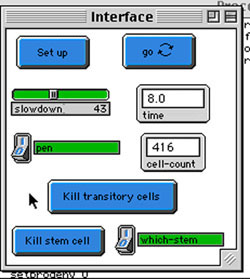
WHAT IS IT?
-----------
This model illustrates the growth of a tumor and how it
resists chemical treatment. A tumor consists of two kinds
of cell: stem cells and transitory cells. During mitosis, a
stem cell can divide asymmetrically, that is, one of its
progeny replaces the dividing parent stem cell, remaining a
stem cell. The other turns into a transitory cell that moves
outward.
Young transitory cells may divide, breeding other transitory
cells. This is known as symmetric division (or amplifying)
division. The transitory cells stop dividing at a certain
age and change color from red to white to black, eventually
dying. Stem cells do not die. Their life ends during a
mitosis when they are replaced by one of their daughter
cells that remains a stem cell. After each division the
stem cell is quasi reincarnated.
A stem cell may also divide into two stem cells (blue
turtles), which is called symmetric division.
In this example the static stem cell divides symmetrically
only once. Its blue progeny starts moving to the right,
dividing asymmetrically as it goes, producing its own
progeny. The second stem cell's activity is called
metastasis. It advances into distant sites and creates
another tumor colony. Notice that the metastasis is red. It
is made of young cells that die young and therefore do not
end as black dots as in the static tumor. As the disease
progresses, cells die younger and younger.
This model was contributed by Gershom Zajicek M.D.,
Professor of Experimental Medicine and Cancer Research at
The Hebrew University-Hadassah Medical School, Jerusalem.
HOW TO USE IT
--------------
SETUP: Clears the display window and creates two blue
neoplastic (cancerous) stem
cells. One cell stays put and the other moves to the
right.
GO: Runs the simulation.
SLOWDOWN: A high value slows down the process.
PEN:If it's 1, the cells trace their paths; if it's 0, they
do not.
KILL TRANSITORY CELLS: Kills transitory cells that are
younger than 5 time steps.
KILL STEM CELL: Kills a stem cell. If the adjacent
WHICH-STEM switch is set to 0, the original is eliminated.
If the switch is set to 1, the moving stem cell is
eliminated.
CELL-COUNT: Displays total number of living cells.
PLOTWINDOW 1: plots the number of living cells.
THINGS TO NOTICE
----------------
Notice a blue dot. It is a normal stem cell that was
transformed into a tumor stem cell. Set the switch tool
called pen to 0, and click on 'go'. A tumor is formed as the
stem cell creates transitory cells, which reproduce
themselves. It grows to a certain size. As it grows, a
bulge appears on the right side. This is a tumor outgrowth,
caused by symmetric mitosis of the stem cell, which will
turn into a metastasis and grow into remote regions.
After a while the tumor and metastasis appear to reach their
ultimate size and nothing interesting seems to be happening.
This illustrates how the tumor presents itself to the
physician -- a solid cell mass. In reality, this seemingly
solid mass conceals active cell turnover. In order to reveal
it, set the pen switch to 0, click on SETUP, and then click
on GO.
Slow down the model so you can follow individual steps. Set
the SLOWDOWN slider to 100, click on SETUP and GO, and
observe the blue stem cell. It divides into two blue stem
cells. One remains static, and the other moves to the
right.
Look at the static stem cell (blue). It breeds red cells
which age, move outward, and change their color as they go.
The tumor is made of cells that move outward, aging as they
go. When young, they are red and create more transitory
cells. Then they turn white, then black, and then they die.
Follow the life and death of an individual cell by
double-clicking on it with the mouse and watching its
individual monitor.
THINGS TO TRY
-------------
Try a treatment: click on the 'kill transitory cells'
button, while the model is running. This simulates treatment
with a chemical agent. The agent eliminates young (red)
cells that divide, and it spares older cells. Note that the
tumor shrinks and grows again. Continue with chemotherapy
(click on 'kill transitory cells') and watch the Plotwindow
1. Repeat the treatment several times until you have
understood why it fails.
Most chemical drugs known as M- and S- poisons inhibit cell
division and generally do not cause cell death. Only young
cells divide. Pushing the "kill transitory cells" button is
like injecting the tumor with a chemical drug that inhibits
cell production by young (red) cells. It does not affect
older transitory cells that do not divide. They continue
aging and finally pass away.
Let the tumor grow again. Then set which-stem switch to 1.
Click on 'kill stem cell' and continue running the model.
The right blue stem cell disappears. Its progeny live a bit
longer and then die.
Set which-stem switch to 0. Click on "kill stem cell", and
watch the gradual disappearance of the tumor, as no new
cells are created and existing cells continue aging until
they die and disappear.
The stem cell, known also as clonogenic cell, is generally
resistant to chemotherapy. It can be eliminated only with
high doses of chemicals, which endanger healthy stem cells.
In other words, the therapeutic margin of chemical drugs is
extremely narrow. The problem is that clonogenic cells
maintain the tumor and propagate its metastases.
Any questions? Before asking, continue exploring the model
until you grasp its behavior. The model reveals a hidden
dimension that is difficult to understand. It is the time
dimension of tissues (and the tumor) in the body.
EXTENDING THE MODEL
-------------------
What alternative treatments would you suggest? How would
you model them here?
